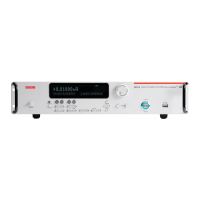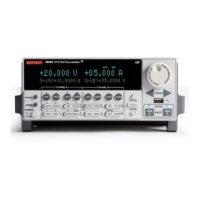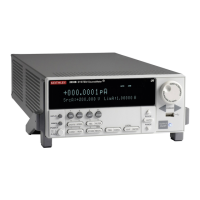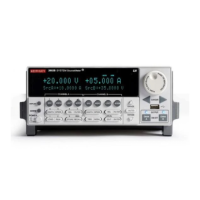9-12 Return to Section Topics 2600S-901-01 Rev. C / January 2008
Section 9: System Expansion (TSP-Link) Series 2600 System SourceMeter® Instruments Reference Manual
Copying test scripts across the TSP-Link network
To run a large script on a remote node, it is highly recommend that you copy the test script to the
remote node to increase the speed of test script initiation.
Use the code below to copy test scripts across the TSP-Link network. This example creates a
copy of a script on the remote node.
Note the following:
• The copy of the test script has the same name as the source
• Replace N with the number of the node that receives a copy of the script
• Replace myscript with the name of the script that you want to copy from the local node
-- Adds the source code from myscript to the data queue.
node[N].dataqueue.add(myscript.source)
-- Creates a new script on the remote node using the source code from myscript.
node[N].execute(myscript.name..“ = script.new(dataqueue.next(),
[[“..myscript.name..“]])“)
Removing stale values from the reading buffer
The node that acquires the data stores the data for the reading buffer. To optimize data access, all
nodes can cache data from the node that stores the reading buffer data.
Running TSL code remotely can cause values in the reading buffer cache to become stale. If the
values in the reading buffer change while the TSL code runs remotely, another node can hold stale
values. Use the clearcache command to clear the cache.
The following code demonstrates how stale values occur and how to use the clearcache
command to clear the reading buffer cache.
Note the following:
• Replace N with the node number
• Replace G with the group number
-- Creates a reading buffer on a node in a remote group.
node[N].tsplink.group = G
node[N].execute("rbremote = smua.makebuffer(20) " ..
"smua.measure.count = 20 " ..
"smua.measure.overlappedv(rbremote)")
waitcomplete(G)
-- Creates a variable on the local node to access the reading buffer.
rblocal = node[N].getglobal("rbremote")
-- Access data from the reading buffer.
print(rblocal[1])
-- Runs code on the remote node that updates the reading buffer.
node[N].execute("smua.measure.overlappedv(rbremote)")
-- Use the clearcache command if the reading buffer contains cached data.
rblocal.clearcache()

